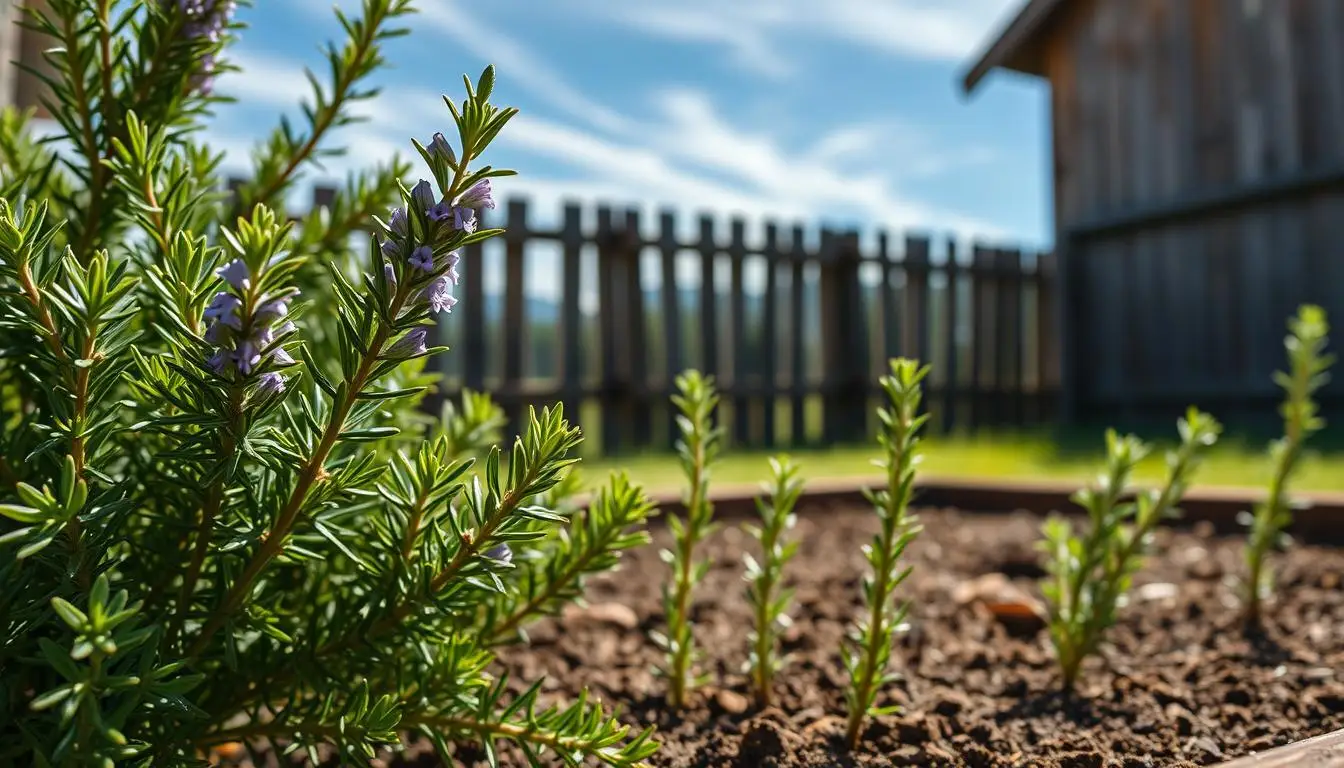
Ever wondered how a single rosemary plant can transform your garden, kitchen, and health? This aromatic Mediterranean herb is more than just a culinary garnish – it’s a versatile botanical wonder that offers incredible benefits for home gardeners and cooking enthusiasts.
The rosemary herb is a resilient and fragrant perennial that thrives in sunny locations, bringing beauty and flavor to your outdoor spaces. Whether you’re a seasoned gardener or a beginner looking to expand your herb collection, growing a rosemary plant can be an exciting and rewarding experience.
From its rich historical background to its practical uses in cooking and wellness, rosemary offers something special for everyone. This comprehensive guide will walk you through everything you need to know about cultivating, caring for, and enjoying this remarkable herb.
Key Takeaways
- Rosemary is a versatile Mediterranean herb with multiple uses
- Suitable for both indoor and outdoor cultivation
- Requires minimal maintenance and thrives in sunny conditions
- Offers culinary, medicinal, and ornamental benefits
- Adaptable to various garden styles and landscapes
Understanding Rosemary: A Mediterranean Herb Classic
Rosemary stands as a remarkable herb with a rich history stretching across centuries and continents. Originating in the Mediterranean region, this aromatic plant has captured the hearts of gardeners, chefs, and healers worldwide. Its distinctive pine-like fragrance and versatile nature make rosemary a truly exceptional botanical treasure.
Historical Roots and Cultural Significance
Ancient civilizations revered rosemary for its symbolic and practical applications. Greeks and Romans considered it a sacred herb associated with memory and remembrance. In traditional practices, rosemary was used during wedding and funeral ceremonies, symbolizing love, remembrance, and protection.
Exploring Rosemary Varieties
Different rosemary varieties offer unique characteristics for gardeners and culinary enthusiasts. Some popular rosemary varieties include:
- Tuscan Blue: Upright growth with intense flavor
- Prostrate Rosemary: Trailing variety perfect for ground cover
- Barbecue Rosemary: Sturdy stems ideal for grilling skewers
- Golden Rain: Variegated leaves with yellow-green coloration
| Rosemary Variety | Growth Habit | Culinary Use |
|---|---|---|
| Tuscan Blue | Upright, 4-5 feet tall | Strong, robust flavor |
| Prostrate | Spreading, ground cover | Mild, delicate taste |
| Barbecue | Compact, sturdy | Excellent for grilling |
Traditional Rosemary Uses
Rosemary uses extend far beyond culinary applications. Traditional medicine has long recognized its potential health benefits. Rosemary essential oil is prized in aromatherapy for improving mental clarity and reducing stress. Culinary enthusiasts appreciate rosemary for enhancing meat dishes, bread, and Mediterranean cuisine.
“Rosemary is for remembrance,” as the famous saying goes, highlighting its deep cultural significance.
From ancient rituals to modern kitchens, rosemary continues to be a beloved herb with remarkable versatility and enduring appeal.
Essential Growing Requirements for Rosemary Plant
Rosemary cultivation demands specific environmental conditions that mirror its Mediterranean origins. This aromatic herb thrives in unique settings that gardeners can recreate with careful attention to its growing requirements.
Successful rosemary growing starts with understanding the plant’s core needs. Sunlight plays a critical role in rosemary’s development. The herb requires:
- Full sun exposure (6-8 hours daily)
- Well-draining soil conditions
- Minimal humidity environments
Temperature is another crucial factor in rosemary cultivation. Ideal growing conditions include:
- Daytime temperatures between 55-80°F
- Nighttime temperatures above 40°F
- Protection from harsh winter conditions
| Growing Condition | Rosemary Requirement |
|---|---|
| Light Exposure | Full direct sunlight |
| Soil Type | Sandy, alkaline soil |
| Water Needs | Low to moderate |
| Temperature Range | 55-80°F |
Pro tip: Rosemary plants prefer environments that mimic their native Mediterranean landscapes – dry, sunny, and with excellent air circulation.
“Rosemary asks little but gives much in return – a true gardener’s companion.” – Mediterranean Herb Growers Association
Planting and Propagation Methods
Rosemary gardening offers multiple exciting ways to expand your herb collection. Whether you’re a beginner or an experienced gardener, understanding different propagation methods can help you successfully grow this aromatic Mediterranean herb.
Growing rosemary requires patience and the right techniques. Gardeners can choose from several effective propagation strategies that suit different skill levels and garden environments.
Starting from Seeds
Seed propagation for rosemary can be challenging but rewarding. Follow these essential steps:
- Use fresh, high-quality rosemary seeds
- Select a warm, sunny location
- Maintain soil temperature around 70°F
- Keep soil consistently moist
- Expect germination in 14-21 days
Propagating from Cuttings
Cuttings represent the most reliable method for rosemary gardening. This technique ensures genetic consistency and faster growth.
| Cutting Type | Best Season | Success Rate |
|---|---|---|
| Softwood Cuttings | Spring | 80-90% |
| Hardwood Cuttings | Late Fall | 60-70% |
Transplanting Tips
Successful rosemary transplanting depends on careful handling and ideal conditions. Timing and technique are crucial for plant survival and healthy growth.
- Choose plants with strong root systems
- Transplant during mild weather
- Ensure well-draining soil
- Water thoroughly after transplanting
- Provide partial shade initially
With these rosemary gardening techniques, you can confidently propagate and establish thriving herb plants in your garden.
Soil Preparation and Location Selection

Selecting the perfect spot and preparing the right soil are critical steps in successful rosemary care. The rosemary plant thrives in specific environmental conditions that mimic its Mediterranean origins.
When choosing a location for your rosemary plant, prioritize areas with abundant sunlight. These herbs love bright, direct sunlight for at least 6-8 hours daily. Outdoor gardens with southern exposure or sunny patios provide ideal growing conditions.
- Select well-draining locations
- Ensure minimum 6 hours of direct sunlight
- Protect from harsh winter winds
- Consider elevated or sloped areas
Soil composition plays a crucial role in rosemary care. The ideal soil should be:
- Sandy or gravelly
- Slightly alkaline (pH 6.0-7.5)
- Low in organic matter
- Extremely well-draining
“The secret to a thriving rosemary plant is mimicking its native Mediterranean landscape.” – Herb Gardening Expert
For container gardening, choose pots with drainage holes and use specialized herbs or cactus potting mix. Terracotta containers work best as they allow moisture to evaporate quickly, preventing root rot.
Pro tip: If your garden soil is heavy clay, consider creating raised beds or mixing in sand and gravel to improve drainage for your rosemary plant.
Watering and Humidity Requirements
Rosemary care demands a delicate balance when it comes to water management. This Mediterranean herb thrives in specific moisture conditions that mimic its native dry, sunny environment. Understanding the right watering techniques is crucial for successful rosemary growing.
Proper Watering Techniques
Rosemary prefers a drought-tolerant approach to watering. Gardeners should follow these key guidelines:
- Water deeply but infrequently
- Allow soil to dry completely between waterings
- Use well-draining soil to prevent root rot
- Check soil moisture at least 1-2 inches below the surface
Managing Moisture Levels
Rosemary growing success depends on understanding the plant’s unique moisture requirements. The herb originates from Mediterranean regions with limited rainfall, so it naturally adapts to dry conditions. Overwatering is the most common mistake gardeners make.
Dealing with Humidity Issues
While rosemary tolerates low humidity, extreme conditions can stress the plant. In high-humidity environments, ensure excellent air circulation and avoid overcrowding. Potted rosemary plants benefit from occasional wind exposure and minimal moisture around the leaves.
“The secret to rosemary care is mimicking its natural Mediterranean habitat: dry, sunny, and well-ventilated.” – Herb Gardening Expert
By following these rosemary care techniques, gardeners can cultivate healthy, robust plants that thrive in various growing conditions.
Pruning and Maintenance Guidelines

Rosemary gardening requires careful pruning to maintain the plant’s health and shape. Proper maintenance helps your rosemary thrive and remain productive throughout the growing season. Regular pruning encourages robust growth and prevents the plant from becoming woody and sparse.
Key pruning guidelines for rosemary care include:
- Prune in early spring or after flowering
- Remove dead or damaged branches
- Cut back up to one-third of the plant’s total growth
- Use clean, sharp pruning shears to prevent disease transmission
Expert gardeners recommend avoiding heavy pruning during winter months. Rosemary is sensitive to cold and extensive trimming can weaken the plant’s structure.
“Gentle pruning is the secret to a healthy, vibrant rosemary plant.” – Garden Wisdom
Maintenance tips for optimal rosemary gardening include:
- Check plants monthly for signs of stress
- Remove any diseased or yellowing leaves
- Ensure proper air circulation around the plant
- Apply organic mulch to retain moisture
By following these rosemary care techniques, gardeners can enjoy a thriving, aromatic herb that adds beauty and flavor to their landscape.
Common Pests and Disease Management
Maintaining a healthy rosemary plant requires vigilant pest and disease management. While these aromatic herbs are generally resilient, they can face challenges that threaten their growth and vitality. Understanding how to identify, treat, and prevent common issues will help ensure your rosemary cultivation remains successful.
Identifying Plant Problems
Rosemary plants can experience several common issues that gardeners should watch for:
- Root rot from overwatering
- Spider mite infestations
- Powdery mildew
- Aphid clusters
- Fungal infections
Natural Treatment Methods
Organic solutions can effectively address most rosemary plant challenges:
- Neem oil spray for pest control
- Prune infected areas immediately
- Use natural fungicides like diluted hydrogen peroxide
- Introduce beneficial insects
- Apply organic insecticidal soap
Prevention Strategies
Proactive care is key to preventing pest and disease problems in rosemary cultivation. Ensure proper drainage, maintain appropriate spacing between plants, and monitor environmental conditions regularly. Good air circulation and controlled watering can significantly reduce the risk of potential plant health issues.
“Healthy plants are your best defense against pests and diseases.” – Gardening Wisdom
Harvesting and Using Fresh Rosemary
Growing rosemary provides a versatile herb for both culinary and aromatherapy purposes. When harvesting rosemary, timing and technique are crucial for maintaining the plant’s health and maximizing your yield.
Optimal harvesting strategies include:
- Cut stems in the morning when essential oils are most concentrated
- Use clean, sharp pruning shears to prevent plant damage
- Harvest up to one-third of the plant’s growth at a time
- Avoid cutting woody stems near the base
Rosemary culinary applications are incredibly diverse. Fresh sprigs can enhance numerous dishes, from roasted meats to vegetable preparations. Mediterranean cuisines particularly celebrate this aromatic herb.
For preserving rosemary, consider these methods:
- Air drying: Hang small bunches in a warm, dry area
- Freezing: Chop leaves and store in ice cube trays with olive oil
- Dehydrating: Use a food dehydrator for quick preservation
Rosemary essential oil extraction requires specialized equipment but offers remarkable benefits. Professional distillation processes capture the herb’s potent aromatic compounds, which are used in aromatherapy, skincare, and natural medicine.
“Rosemary transforms ordinary cooking into a sensory experience” – Culinary Experts
Whether you’re a home cook or herbal enthusiast, your homegrown rosemary can elevate both culinary creations and wellness routines.
Conclusion
Growing a rosemary herb can transform your garden and culinary experiences. This Mediterranean plant offers more than just a delightful aroma—it provides a gateway to fresh, homegrown flavors and natural wellness. Whether you’re a seasoned gardener or a beginner, rosemary uses extend far beyond simple decoration.
The techniques you’ve learned about cultivation, care, and maintenance will empower you to successfully grow this versatile herb. From understanding soil requirements to managing potential pest challenges, you now possess the knowledge to nurture a thriving rosemary plant. Each step in your gardening journey brings you closer to enjoying fresh, aromatic rosemary right from your own garden.
Remember that patience and consistent care are key to developing a robust rosemary herb. Start small, observe your plant’s growth, and don’t be afraid to experiment with different propagation methods. Your rosemary plant will not only enhance your cooking but also serve as a beautiful, fragrant addition to your outdoor or indoor space.
Embrace the joy of growing this remarkable herb and discover the endless possibilities it brings to your home and kitchen. Your rosemary adventure starts now—happy gardening!
FAQ
How much sunlight does rosemary need?
Rosemary thrives in full sun, requiring at least 6-8 hours of direct sunlight daily. It’s a Mediterranean herb that loves bright, warm conditions, so choose a location with plenty of sunshine for optimal growth.
Can I grow rosemary indoors?
Yes, you can grow rosemary indoors! Choose a sunny windowsill with southern exposure, use a well-draining pot, and ensure good air circulation. Rotate the plant occasionally to promote even growth and provide supplemental grow lights if natural light is limited.
How often should I water my rosemary plant?
Rosemary prefers to be on the drier side. Water only when the top inch of soil feels dry, typically every 1-2 weeks. Avoid overwatering, as rosemary is susceptible to root rot. In winter, reduce watering frequency even further.
What type of soil is best for rosemary?
Use a well-draining, sandy soil with a pH between 6.0 and 7.0. A mix of potting soil with sand or perlite works great. The key is to prevent water from sitting around the roots, which can cause decay.
How do I propagate rosemary?
The easiest method is propagation by cuttings. Take 4-6 inch softwood cuttings from healthy stems, remove lower leaves, and place in a well-draining rooting medium. Keep the cuttings warm and moist until roots develop, which typically takes 2-3 weeks.
What are common pests that affect rosemary?
Rosemary can be attacked by spider mites, aphids, and whiteflies. Regularly inspect your plant and use natural treatments like neem oil or insecticidal soap. Ensure good air circulation and avoid overwatering to prevent pest infestations.
How do I harvest rosemary?
Harvest rosemary by cutting sprigs in the morning after dew has dried. Use clean, sharp scissors and cut just above a leaf intersection. Never remove more than 1/3 of the plant at once, and avoid harvesting during flowering to maintain plant health.
Can I use rosemary for cooking and other purposes?
Absolutely! Rosemary is incredibly versatile. Use fresh or dried leaves in cooking, especially with meats and roasted vegetables. It’s also great for making herbal teas, essential oils, and has medicinal properties used in aromatherapy and traditional medicine.
How do I overwinter rosemary?
In cold climates, bring potted rosemary indoors before first frost. Place in a bright, cool location around 55-65°F. Reduce watering, ensure good air circulation, and protect from cold drafts. In milder zones, provide winter protection with mulch or bring container plants close to a building for warmth.
What are some popular rosemary varieties?
Some popular varieties include ‘Arp’ (cold-hardy), ‘Tuscan Blue’ (upright growth), ‘Prostratus’ (trailing variety), and ‘Blue Spears’ (compact form). Each variety has unique characteristics suited to different growing conditions and garden designs.









Good information thank you 🙂🙂